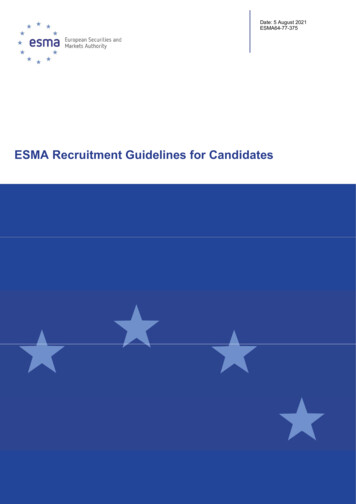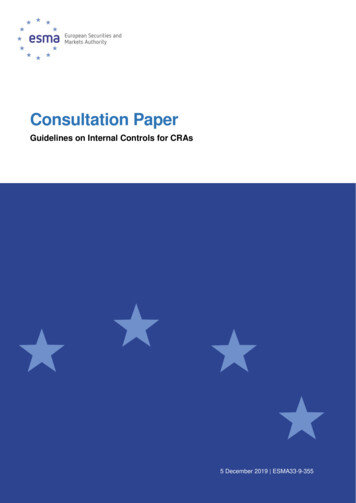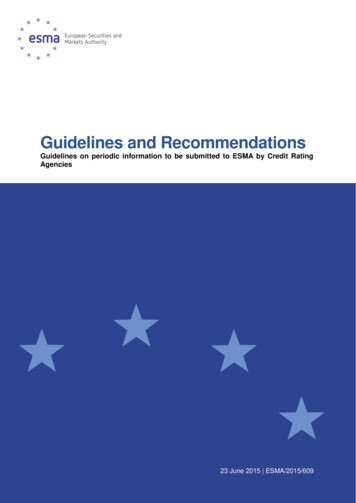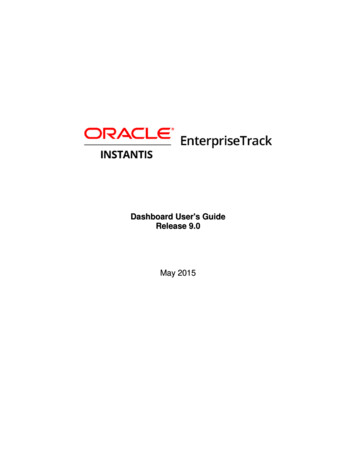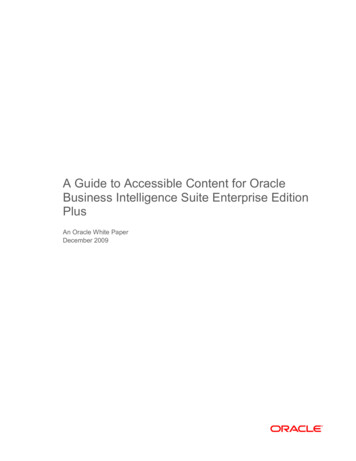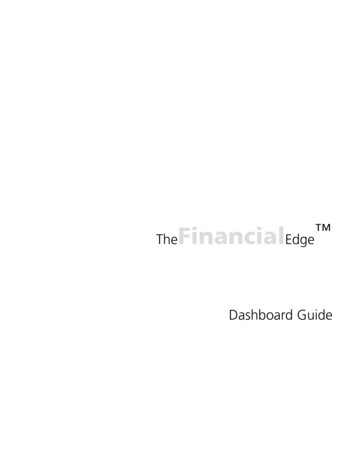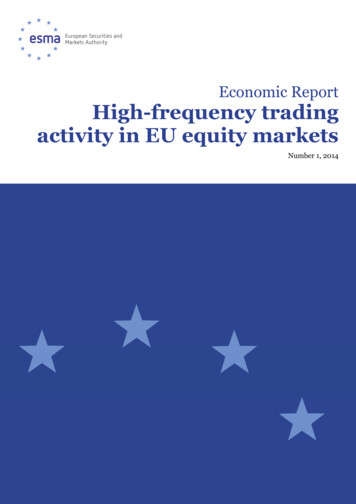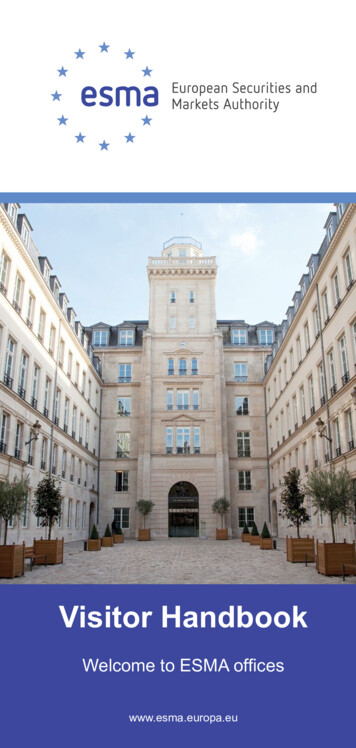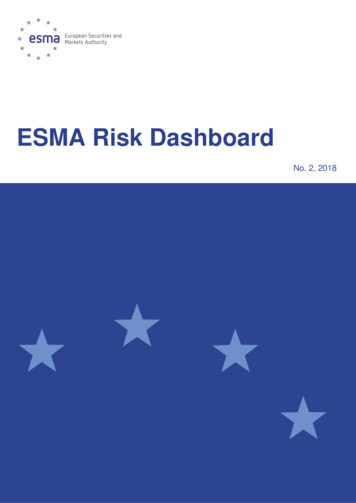
Transcription
DgufdhESMA Risk DashboardNo. 2, 2018
ESMA Risk DashboardNo. 2, 20182ESMA Risk DashboardNo. 2, 2018 European Securities and Markets Authority, Paris, 2018. All rights reserved. Brief excerpts may be reproduced or translatedprovided the source is cited adequately. The reporting period of this Report is 1 January 2018 to 31 March 2018, unless indicatedotherwise. Legal reference of this Report: Regulation (EU) No 1095/2010 of the European Parliament and of the Council of24 November 2010 establishing a European Supervisory Authority (European Securities and Markets Authority), amendingDecision No 716/2009/EC and repealing Commission Decision 2009/77/EC, Article 32 “Assessment of market developments”, 1.“The Authority shall monitor and assess market developments in the area of its competence and, where necessary, inform theEuropean Supervisory Authority (European Banking Authority), and the European Supervisory Authority (European Insuranceand Occupational Pensions Authority), the ESRB and the European Parliament, the Council and the Commission about therelevant micro-prudential trends, potential risks and vulnerabilities. The Authority shall include in its assessments an economicanalysis of the markets in which financial market participants operate, and an assessment of the impact of potential marketdevelopments on such financial market participants.” The information contained in this publication, including text, charts and data,exclusively serve analytical purposes. They do not provide forecasts or investment advice, and do not prejudice, preclude orinfluence in any way past, existing or future regulatory or supervisory obligations by market participants.The charts and analyses in this report are, fully or in parts, based on data not proprietary to ESMA, including from commercialdata providers and public authorities. ESMA uses these data in good faith and does not take responsibility for their accuracy orcompleteness. ESMA is committed to constantly improving its data sources and reserves the right to alter data sources at anytime. The third-party data used in this publication may be subject to provider-specific disclaimers, especially regarding itsownership, its reuse by non-customers and, in particular, the accuracy, completeness or timeliness of the data provided and theprovider’s liability related to those. Please consult the websites of the individual data providers, whose names are detailedthroughout this report, for more details on these disclaimers. Where third-party data are used to create any chart, table or analysisthe third party is identified and credited as the source. In each case, ESMA is cited by default as a source, reflecting any datamanagement, cleaning, processing, matching, analytical, editorial or other adjustments to raw data undertaken.European Securities and Markets Authority (ESMA)Risk Analysis and Economics Department103, Rue de GrenelleFR–75007 Parisrisk.analysis@esma.europa.eu
ESMA Risk DashboardNo. 2, 20183ESMA Risk DashboardR.1Main risksRisk segmentsLevel OutlookOverall ESMA remitSystemic stressSecurities marketsInvestorsInfrastructures and services Risk categoriesLevel OutlookLiquidityMarketContagionCreditOperational Risk sourcesOutlookMacroeconomic environmentLow interest rate environmentEU sovereign debt marketsInfrastructure disruptions, incl. cyber risksPolitical and event risks Note: Assessment of main risks by risk segments for markets under ESMA remit since last assessment, and outlook for forthcoming quarter. Assessment of main risks byrisk categories and sources for markets under ESMA remit since last assessment, and outlook for forthcoming quarter. Risk assessment based on categorisation of the ESAJoint Committee. Colours indicate current risk intensity. Coding: green potential risk, yellow elevated risk, orange high risk, red very high risk. Upward arrows indicate anincrease in risk intensities, downward arrows a decrease, horizontal arrows no change. Change is measured with respect to the previous quarter; the outlook refers to theforthcoming quarter. ESMA risk assessment based on quantitative indicators and analyst judgement.In 1Q18, equity markets in the EU and elsewhere saw significant price corrections, with a 6% drop inEU stock prices in the week of 5 February alone, and the return of market volatility. The episodeconfirms our concerns that market risks are and will continue to be very high, resulting from ambitiousasset valuations in equities as well as market uncertainty as the period of ultra-low interest rates drawsto a close. Our outlook for liquidity, contagion and credit risk remains unchanged. Operational riskcontinues to be elevated, with a deteriorating outlook, as Brexit-related risks to business operations andvulnerabilities to cyber-attacks rise. Investor risks have been mounting across a range of products, andESMA has, following our earlier risk alert on Initial Coin Offerings (ICOs)1, issued a pan-EU warning toconsumers regarding the risks of buying Virtual Currencies 2. Moreover, under the MiFIR productintervention powers, the ESMA Board agreed on a temporary prohibition of Binary Options andrestrictions on Contracts for Difference (CFDs)3, respectively.Risk summaryValuation risk materialised in early February withstrong correction on global equity markets,starting in the US, and spreading into otherjurisdictions, including the EU. Even thoughmarkets stabilised since, this episode pays tributeto the valuation risks and fragility of securitiesmarkets highlighted by ESMA in its previous riskassessments. Against this background, marketrisk remained at a very high level in 1Q18, andother ESMA risks categories remained at highlevels, reflecting very high risk in securitiesmarkets and elevated risk for investors,infrastructures and services. The level of creditand liquidity risk remained high with adeterioration in outstanding corporate ratings,deteriorating corporate bond liquidity measuresand with potential collateral scarcity signs stillpresent. Operational risk was elevated, with therapid growth in the number of VCs and ICOcampaigns as a source of risk for investors. Onthis matter, the ESAs issued a joint warning to123consumers in February. Cyber risk also remainsa major concern.R.2ESMA composite systemic stress indicatorLow, with equity driven spikes0.60.40.20-0.2-0.4Mar-14Mar-15Mar-16Equ ity mar ket con trib utio nMoney mar ket con trib utio nCorrela tio n contribu tionMar-17Mar-18Bon d market contribu tionESMA CISSNote: ESMA version of the ECB-CISS indic ator meas uring sys temic str ess insecurities markets. It foc uses on three financial market s egments: equity , bondand money markets , aggregated through standard portfolio theory. It is bas ed onsecurities market indicators such as volatilities and risk spreads.Sources: ECB, ESMA.Risk les/library/esma50-157-829 ico statement ult/files/library/esma50-164-1284 joint esas warning on virtual ault/files/library/esma35-431000 additional information on the agreed product intervention measures relating to contracts for differences andbinary options.pdf
ESMA Risk DashboardNo. 2, 2018Macroeconomic environment: Growth forecastsin the EU have been raised by the EuropeanCommission in its Winter 2018 Interim EconomicForecast4. In the US, the annual rate of headlineinflation (2.1% in January) was stronger than theconsensus forecast, reigniting investors’ fears ofmore aggressive interest rate increases. Themacroeconomic environment and its interactionwith market expectations, notably over futuremonetary policy actions, played an active role inFebruary’s market correction and remain asignificant risk source going forward.Low interest-rate environment: During 1Q18markets showed signs of a risk premia reversalrelated to a move out of the low interest rateenvironment. Starting in the US, stronger thanexpected economic recovery, inflation figuresand salary increases as well as a recent tax cutplan have renewed concerns over a moreaggressive monetary policy tightening thananticipated. This triggered a global equity sell offin February In the high-yield (HY) segment, yieldson the main benchmark, which had beendeclining since early 2016 started to increase atthe end of 2017, potentially reflecting a curbing ofsearch for yield behaviour5. HY bond funds alsoexperienced net outflows over the reportingperiod (R.25). Markets reactions to monetarypolicy actions and the phase-out of the lowinterest rates environment will be interlinkedgoing forward. Hence, our risk outlook for thiscategory is deteriorating.EU sovereign debt markets: Liquidity onsovereign bond markets, as measured by bid-askspreads (R.10) and the ESMA compositeilliquidity indicator (R.11) remained relatively lowin 1Q18 compared to historical levels. Fiscalfragilities remain at country level and repricingrisk in sovereigns following a more general riskpremia reversal in global markets still holds. Thisrisk has started to materialise at the beginning ofFebruary in equity markets and with increasingsovereign bond risk premia with respect to the DEbund around the equity sell-off, althoughsovereign bond spreads decreased later on.Sovereign yields decreased across jurisdictions,by 18 bps on average for ten-year bonds sincethe end of January.4been implemented successfully with long-termimpacts to be investigated. In relation to darktrading, ESMA published the first Double VolumeCap (DVC) data on 7 March. Volumes for theaffected securities declined by 10% in March, inparticular in dark pools (-85%). Generally,markets did not suffer major disruptions in 1Q18,including the episode of high equity price volatilityat the beginning of February. Nevertheless, thenumber of circuit breakers occurrences, whichaveraged at 104 occurrences per week inJanuary, jumped to 400 occurrences during theweek of 5 February. Overall, the average weeklynumber of circuit breaker occurrences was 169,around long-term averages (R.35). Regardingmarket infrastructures, central clearing continuedto increase as the implementation of the clearingobligation for derivatives is ongoing. With respectto securities settlement systems, followingcompletion of to the final migration wave to T2S,EU CSDs have applied for authorisation underCSDR. Two CSDs have already been authorisedand the process is ongoing for most of the others.Although the total value of settled transactions inthe EU remained around the same levels, theshare of settlement fails increased for equities atthe end of 1Q18 (R.38). Finally, cyber riskremained a concern for financial marketinstitutions especially with respect to theirbusiness continuity and the integrity ofproprietary data, as data theft is still the mainsource of breaches in the financial sector (R.43)Political and event risk: In the EU, Brexit remainsamong the most important political risks. Continuityof contracts and access to financial marketinfrastructures will be crucial to avoid potentialcliff-edge effects upon Brexit. Growinguncertainty around trade and global marketpolicies could also pose a threat to the continuedimprovement of trade and capital marketintegration in the EU and in other jurisdictions.Market functioning: MiFIDII/MiFIR entered intoforce on 3 January 2018 with preliminary analysisshowing that the new regulatory framework asts/winter-2018-economic-forecastICE Benchmark Administration Limited (IBA), ICEBofAML Euro High Yield Index Effective Yield[BAMLHE00EHYIEY], retrieved from FRED, FederalReserve Bank of St. HYIEY,April 18, 2018.
ESMA Risk DashboardNo. 2, 2018Risk categoriesMarket risk – very high, outlook stable: Marketswere mainly driven by reignited fears of a moreaggressive rise in interest rates by the FederalReserve this year, and the potential divergence indirecting rates across jurisdictions. Equitymarkets first increased in January, remaining ontheir ascending trend of 2017, but decreasedsharply after the publication of stronger thananticipated economic, inflation and wageincrease indicators in the US. This marketcorrection confirmed our ongoing concerns overhigh equity valuations and market uncertainty asthe period of ultra-low interest rates draws to aclose. The EuroStoxx 50 lost 6% between endJanuary and the end of 1Q18. Short-termexpectations of equity price volatility ticked upfrom 11.2% to close to 50% over these concerns,reaching multi-year highs (R.7). Exchange ratevolatilities also ticked-up, reflecting theappreciation of the EUR, notably against the USD(R.8).Liquidity risk – high, outlook stable: Acrossmarkets, episodes of deteriorating liquidityoccurred, especially since the February marketcorrections. The ESMA composite equity liquidityindex deteriorated in February before returning toits long-term average (R.4). For sovereign bonds,liquidity improved in 1Q18 although it starteddeteriorating toward the end of the quarter (R.10,R.11). Liquidity as measured by the Amihudindicator deteriorated in February and corporatebond bid-ask spreads also deteriorated sincethen (R.16). The trading volume of centrallycleared repos increased in January andFebruary, and started decreasing after (R.13).Collateral scarcity premia (i.e. the differencebetween general collateral and special collateralrepo rates) remained reactive to market events.High levels of collateral scarcity premia reflectpossible shortages of high-quality collateral(R.14). This may increase liquidity risk, volatilityin funding costs and reduce overall marketconfidence.Contagion risk – high, stable outlook: Onsovereign bond markets, the median correlationbetween Germany and other EU countries’ bonddecreased during the first half of 1Q18 althoughit remained above 0.9. Dispersion levels weremainly driven by low-rated member states whichwere subject to credit rating improvements duringthe quarter (R.19). As the repricing of equity haspartly materialised during 1Q18, contagion toother markets could occur via the highinterconnectedness of hedge funds to moretraditional banking activities (R.29). Financial5contagion can also occur via derivativeexposures. On derivative markets, CCPs play animportant risk mitigation role but can have thepotential to cause serious systemic risk in case offailure. In its second EU-wide CCP stress test,ESMA tested the resilience of 16 EuropeanCCPs. The results showed that overall thesystem of EU CCPs is resilient to multipleclearing member defaults and extreme marketshocks.Credit risk – high, outlook stable: In 1Q18, nonfinancial corporate bond spreads increased forlow-ratings (BBB) starting in February as a resultof asset reallocation and following marketmovements for equities and bonds. Spreadincreases were more pronounced for low-ratedbonds, which could be considered as a sign ofshifting risk perceptions linked to risk premiareversals. Spreads stood in the range of 79 bpsfor BBB-rated securities to 5.8 bps for the AAAclass (R.15). At the same time, credit quality ofoutstanding corporate bonds continued todeteriorate (R.17).Operational risk – elevated, outlook deteriorating:ESMA recently identified several significantinvestor protection and conduct risk concerns inthe EU. The ESAs issued on 6 February a panEU warning to consumers regarding the risks ofbuying Virtual Currencies. Risks highlightedinclude volatility and bubble risk, the lack of arobust secondary market, operational disruptionsas well as the lack of price transparency.Furthermore, virtual currency platforms are notregulated under EU law, and consumers do notenjoy any of the specific safeguards and legalprotections that are associated with regulatedfinancial services. In relation to Contracts forDifferences (CFDs) and binary options offered toretail investors, ESMA’s Board of Supervisorshas agreed on 27 March product interventionmeasures under Article 40 of MiFIR on theprohibition / restriction of marketing, distributionor sale of binary options and CFDs to retailinvestors. Regarding cyber risks, concerns areexpected to intensify in the medium to long termas financial data breaches are more and morefrequent when compared to breaches in othersectors (R.43); as a result, the risk outlook foroperational risk is deteriorating. Finally, the totalvolume of market participants’ complaintsdecreased over the reporting period, with theirmajority remaining linked to order execution forbond and equity securities (R.32-R.33). Thedispersion of Euribor submission quotesincreased in early 1Q18 (R.41), driven by thesubmissions of one bank.
ESMA Risk DashboardNo. 2, 20186Securities marketsR.3Risk summaryRisk driversRisk level Risk change from 4Q17 Outlook for 2Q18– Risk-premia reversal– Geopolitical and event risks– Potential scarcity of collateralNote: Assessment of main risk categories for markets under ESMA remit since past quarter, and outlook for forthcoming quarter. Systemic risk assessment based oncategorisation of the ESA Joint Committee. Colours indicate current risk intensity. Coding: green potential risk, yellow elevated risk, orange high risk, red very highrisk. Upward arrows indicate a risk increase, downward arrows a risk decrease. ESMA risk assessment based on quantitative indicators and analyst judgement.R.4ESMA composite equity liquidity indexR.5Equity valuationAround long term averageReturning to average in EU0.3850.3640.3430.320.30Mar-162Jul-16Nov-16 Mar-17Illiquid ity indexJul-17Nov-17 Mar-182Y- MANote: Composite i ndicator of illiquidity in the equity market for the c urrentEurostoxx 200 constituents, com puted by applying the principal componentmethodology to six input liquidity meas ures (Amihud illiquidity coefficient, bid-askspread, Hui-Heubel ratio, turnov er value, inverse turnov er ratio, MEC). Theindicator range is between 0 (higher liquidity) and 1 (lower liquidity).Sources: Thomson Reuters Datastream, ESMA.1Mar-16Jul-16Nov-16 Mar-17Adj usted P/E E AAdj usted P/E USJul-17Nov-17 Mar-18A ve rage EAA ve rage USNote: Monthly earni ngs adjus ted for trends and cyclical factors via Kalman filtermethodology based on OECD leading indicat ors; units of standard deviation;averages computed from 8Y.Sources: Thomson Reuters Datastream, ESMA.R.6Equity pricesR.7Financial instruments volatilitiesMarket correction in FebruaryFebruary spike, remaining at higher levels GBP 10 YNov-17 Mar-18USD 10 Y259080Mar-16Jul-16Nov-16EUR 10 v-17 Mar-18BanksFinancial servicesNote: STOXX Europe 600 equity total return indices. 01/03/2016 100.0Mar-16Jul-16Nov-16VSTOX X 1 MVSTOX X 1 2MMar-17Jul-17Nov-17 Mar-18VSTOX X 3 MVSTOX X 2 4MNote: T op panel: implied vol atilities on one-month Euro-Euribor, UK PoundSterling-GBP Li bor and US Dollar-USD Libor swaptions measured as priceindices, in %; bottom panel: Euro Stoxx 50 implied volatilities, meas ured asprice indices, in %.Sources: Thomson Reuters EIKON, Thomson Reuters Datastream, ESMA.R.8Exchange rate volatilitiesR.9Sovereign risk premiaTemporary increase in February across ratesSpike in February across USDGBP-USDMar-17Jul-17Nov-17Mar-18EUR-GBP5Y-MA EURNote: Implied volatilities for 3M options on exchange rates. 5Y-MA EUR is the five-yearmoving average of the implied volatility for 3M options on EUR-USD exchange rate.Sources: Thomson Reuters EIKON, 0Mar-18GR ( rhs)Note: Selected 10Y EA sovereign bond risk premia (vs. DE Bunds), in %.Sources: Thomson Reuters Datastream, ESMA.
ESMA Risk DashboardNo. 2, 20187R.10Sovereign bond bid-ask spreadsR.11ESMA composite sovereign bond illiquidity indexReturn to average in 1Q18 after year-end spikeRelatively low liquidity levels remain0.60.120.110.40.100.20.090.0Mar-16 Jul-16 Nov-16 Mar-17 Jul-17 Nov-17 Mar-18Eur o MTSDomestic MTS1Y MA Domestic1Y MA E uro sk Euro MTS1Y MA Euro MTSNov-17Mar-18Bid-ask Domestic MTS1Y MA Domestic MTSNote: Bi d-ask spread as av erage bid ask spread throughout a month across ten EUmarkets, Domestic and Euro MTS, in %.Sources: MTS, ESMA.R.12Sovereign CDS volumesNote: C omposite indicator of market liquidity in the sov ereign bondmarket for the dom estic and Euro MTS platforms, computed by applyingthe principal c omponent methodol ogy to four i nput liquidity meas ures(Amihud illiquidity c oeffici ent, Bid-ask spread, Roll illiquidity meas ureand Turnover). 1Y MA one-year movi ng aver age. T he i ndicator rangeis between 0 (higher liquidity) and 1 (lower liquidity).Sources: MTS, ESMA.R.13Sovereign repo volumesStable or decreasingIncrease until end-February, decline 16Jul-16DEITNov-16ESPTMar-17Jul-17FREU ( rhs)0Nov-17 Mar-18IE75Mar-16Jul-16Nov-16Mar-17Jul-17Vol umeNov-17Mar-181M-MANote: Val ue of outstanding net notional s overei gn CDS for s elected countries;USD bn.Sources: DTCC, ESMA.Note: Repo trans action vol umes ex ecuted through CCPs in sev en sover eign EURrepo markets (AT, BE, DE, FI, FR, IT and NL), EUR bn.Sources: RepoFunds Rate, ESMA.R.14Repo markets specialnessR.15Corporate bond spreadsReactive to February market eventsIncreased starting in dianMar-17Jul-1775th percNov-17Mar-1890th percNote: Medi an, 75th and 90th percentile of weekly specialness, meas ured as thedifference between gener al coll ateral and special c ollateral repo rates ongovernment bonds in selected countries.Sources: RepoFunds Rate (BrokerTec, MTS, ICAP), r-18BBBNote: EA non-financial corporate bond spreads by rating between iBoxx non-financialcorporate yields and ICAP Euro Euribor swap rates for maturities from 5 to 7 years, inbps.R.16Corporate bond bid-ask spreads and Amihud indicatorR.17Outstanding long term corporate debtAmihud reactive to February market eventsIncreased share of ratings at BBB and Jul-16Nov-16Bid-AskMar-17Jul-171Y-MA0.0Nov-17 Mar-18Amihud (rhs)Note: EUR Markit iBoxx corporate bond index bid-ask spread, in %, computed as aone-month moving average of the iBoxx components in the current composition. 1YMA one-year moving average of the bid-ask spread. Amihud liquidity coefficient indexbetween 0 and 1. Higher value indicates less 71Q18BB and lowerNote: Outstanding amount of corporate bonds in the EU as of issuance date by ratingcategory, in% of the total.
ESMA Risk DashboardNo. 2, 20188R.18Covered bond spreadsR.19Dispersion in sovereign yield correlationIncrease in FebruaryHigh 7AAAJul-17AANov-17Mar-18A5Y- MANote: Ass et swap spreads based on iBoxx covered bond indices, in bps. 5YMA five-year moving average of all bonds.Sources: Thomson Reuters Datastream, ESMA.-1.0Mar-16Jul-16Top 25%Nov-16 Mar-17Core 50%Jul-17Nov-17Bottom 25%Note: Dispersion of correlations between 10Y DE Bunds and other EU countries'sovereign bond redemption yields over 60D rolling windows.Jul-16Nov-16Ban ksInsu ranceMar-17Jul-17Nov-17 Mar-18Financial Ser vicesNFCsNote: Correlati ons between daily returns of the STOXX Europe 600 and ST OXXEurope 600 sectoral indices . Calculated ov er 60D rolling windows. NFCs standsfor Non-Financial Corporations.Sources: Thomson Reuters Datastream, ESMA.R.22Net sovereign debt issuance1Y lowSEC 1Q18SOV 1Q 16SEC 1Q17SEC 1Q16CB 1 Q18MM 1Q1 8Curren tMedianLower short-term financing needs for MTNLPLPTROSESISKEU1Y high90%Note: Growth rates of issuance v olume, i n %, normalised by standard deviati onfor the foll owing bond class es: high yield (HY); inv estment grade (IG); cov eredbonds (CB); money m arket (MM); securitised (SEC); sov ereign (SOV).Percentiles c omputed from 12Q rolling window. All data i nclude s ecurities with amaturity higher than 18M, except for MM (maturity less than 12M). Bars denotethe range of values betw een the 10th and 90th percentil es. Missing diamondindicates no issuance for previous quarter.Sources: Thomson Reuters EIKON, ESMA.R.23Debt redemption profileNegative net issuance in the EU3020100-10-20-30-40-5010%MM 1Q1 70.4Mar-16MM 1Q1 60.5CB 1 Q170.6IG 1 Q180.7CB 1 Q160.8IG 1 Q173210-1IG 1 Q16Decline in issuance across bond classes1.0HY 1 Q18Higher cross-sectoral correlationsHY 1 Q17R.21Debt issuance growthHY 1 Q16R.20Sectoral equity indices correlation0.9Mar-18MedianSOV 1Q 18Jul-16SOV 1Q 170Mar-169060300-30-60-90-120-1501Q1 8Note: Quarterly net issuanc e of EU sover eign debt by c ountry, EUR bn. Netissuanc e calc ulated as the difference betw een new issuance over the quarter andoutstanding debt maturing over the quarter. Highest and low est quarterly netissuance in the past year are reported. EU total on right-hand scale.Sources: Thomson Reuters EIKON, ESMA.4001003000200-100100-20001Q1 81Q1 91Q2 0Financial s1Y- cha nge fin (rhs)1Q2 1-3001Q2 21Q2 3Non-finan cia ls1Y- cha nge non-fin (rhs)Note: Quarterly redempti ons ov er 5Y-horizon by EU private financial and nonfinanci als c orporates, EUR bn. 1Y-change differenc e between the sum of thisyear's (four last quarters) and last year's (8th to 5th last quarters) redemptions.Sources: Thomson Reuters EIKON, ESMA.
ESMA Risk DashboardNo. 2, 20189InvestorsR.24Risk summaryRisk driversRisk level Risk change from 4Q17 Outlook for 2Q18– Asset re-valuation and risk re-assessment– Correlation in asset prices– Risky market practices: VCs, ICOsNote: Assessment of main risk categories for markets under ESMA remit since past quarter, and outlook for forthcoming quarter. Systemic risk assessment based oncategorisation of the ESA Joint Committee. Colours indicate current risk intensity. Coding: green potential risk, yellow elevated risk, orange high risk, red very high risk.Upward arrows indicate a risk increase, downward arrows a risk decrease. ESMA risk assessment based on quantitative indicators and analyst judgement.R.25Cumulative global investment fundR.26EU bond fund net flowsStrong inflows into EM fundsNet outflows for HY and corporate bond 500-1,000Mar-16Jul-16Nov-16 Mar-17Eur ope BFEmergi ng mar kets BFNorth A me rica BFJul-17Eur ope EFEmergi ng mar kets EFNorth A me rica EFNote: C umulativ e net fl ows into bond and equity funds (BF and EF) over timesince 2004 by regional investment focus, EUR bn.Sources: Thomson Reuters Lipper, ESMA.Sep -16Govern me ntCorpor ateNov-17 Mar-18Mar-17Sep -17Emergi ngMixedBon dsMar-18HYOtherNote: Two-month cumul ative net fl ows for bond funds, EUR bn. Funds inves tingin corporate and government bonds that qualify for another category are onlyreported onc e e.g. funds i nvesti ng in emerging gov ernment bonds reported asEmerging; funds investing in HY corporate bonds reported as HY).Sources: Thomson Reuters Lipper, ESMA.R.27RoR volatilities by fund typeR.28Liquidity risk profile of EU bond fundsSpike in volatility, especially for equity fundsStable liquidity and mixed maturity 16Alterna tiveCommo dityMar-17Jul-17Equ ityMixedNov-17Bon dReal EstateNote: Annualised 40D hist orical return volatility of EU domiciled mutual funds, in%.Sources: Thomson Reuters Lipper, ESMA.R.29Financial market interconnectedness5Loa n fundsM aturityGovern me nt BF7Corpor ate BF9Others B FHY fund sNote: F und type is reported acc ording to their average liquidity ratio, as apercentage (Y-axis), the effective average maturity of their assets (X-axis) andtheir size. Eac h series is reported for 2 years, i.e. 2016 (bright colours) and 2017(dark colours).Sources: Thomson Reuters Lipper, ESMA.Higher for equity funds2080157510705650604Q134Q14Total fundsBond funds3R.30Retail fund synthetic risk and reward indicatorHigh for HFs4Q120Mar-184Q154Q164Q17Hedge fundsMMFs (rhs)Note: Loan and debt securities vis-à-vis MFI counterparts, as a share of total assets.EA investment funds and MMFs, in %. Total funds includes: bond funds, equity funds,mixed funds, real estate funds, hedge funds, MMFs and other non-MMFs investmentfunds.7531Mar-16Jul-16Nov-16Equ ityAlterna tiveMoney Mar ketMar-17Jul-17Nov-17Mar-18Bon dCommo dityReal EstateNote:The c alculated Sy nthetic Risk and Rewar d Indicator is bas ed on ESMASRRI guidelines . It is computed via a simple 5 year annualis ed vol atilitymeasure which is then translated into categories 1- 7 (with 7 representinghigher levels of volatility).Sources:Thomson Reuters Lipper, ESMA.
ESMA Risk DashboardNo. 2, 201810Infrastructures and servicesR.31Risk summaryRisk driversRisk level Risk change from 4Q17 Outlook for 2Q18– Operational risks, incl. cyber risks– Conduct risk, incl. intentional or accidental behaviour byindividuals, market abuse– ructures or financial activities, system substitutabilityNote: Assessment of main risk categories for markets under ESMA remit since past quarter, and outlook for forthcoming quarter. Systemic risk assessment based oncategorisation of the ESA Joint Committee. Colours indicate current risk intensity. Coding: green potential risk, yellow elevated risk, orange high risk, red very high risk.Upward arrows indicate a risk increase, downward arrows a risk decrease. ESMA risk assessment based on quantitative indicators and analyst judgement.R.32Complaints indicator by rationaleR.33Complaints indicator by instrumentExecution of orders main cause for complaint100Mostly related to equity and bond instruments500 0100003Q1 4 1Q1 5 3Q1 5 1Q1 6 3Q1 6 1Q1 7Other causesGeneral adminQuality/lack of InformationInv
binary_options.pdf consumers in February. Cyber risk also remains a major concern. R.2 ESMA composite systemic stress indicator Low, with equity Equity market contributiondriven spikes Risk sources -0.4-0.2 0 0.2 0.4 0.6 Mar-14 Mar-15 Mar-16 Mar-17 Mar-18 Bond market contribution Money market contribution ESMA CISS Correlation contribution
